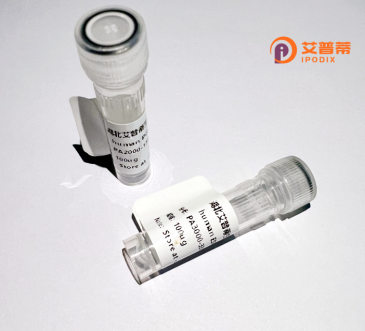
| 纯度 | >90%SDS-PAGE. |
| 种属 | Human |
| 靶点 | CCDC83 |
| Uniprot No | Q8IWF9 |
| 内毒素 | < 0.01EU/μg |
| 表达宿主 | E.coli |
| 表达区间 | 1-413aa |
| 氨基酸序列 | MENSGKANKKDTHDGPPKEIKLPTSEALLDYQCQIKEDAVEQFMFQIKTLRKKNQKYHERNSRLKEEQIWHIRHLLKELSEEKAEGLPVVTREDVEEAMKEKWKFERDQEKNLRDMRMQISNAEKLFLEKLSEKEYWEEYKNVGSERHAKLITSLQNDINTVKENAEKMSEHYKITLEDTRKKIIKETLLQLDQKKEWATQNAVKLIDKGSYLEIWENDWLKKEVATHRKEVEELKNAIHELEAENLVLIDQLSNCRLVDLKIPRRLYLTQAAGLEVPPEEMSLELPETHIEEKSELQPTEVESRDLMSSSDESTILHLSHENSIEDLQYVKIDKEENSGTEFGDTDMKYLLYEDEKDFKDYVNLGPLGVKLMSVESKKMPIHFQEKEIPVKLYKDVRSPESHITYKMMKSFL |
| 分子量 | 75.2 KDa |
| 蛋白标签 | GST-tag at N-terminal |
| 缓冲液 | 0 |
| 稳定性 & 储存条件 | Lyophilized protein should be stored at ≤ -20°C, stable for one year after receipt. Reconstituted protein solution can be stored at 2-8°C for 2-7 days. Aliquots of reconstituted samples are stable at ≤ -20°C for 3 months. |
| 复溶 | Always centrifuge tubes before opening.Do not mix by vortex or pipetting. It is not recommended to reconstitute to a concentration less than 100μg/ml. Dissolve the lyophilized protein in distilled water. Please aliquot the reconstituted solution to minimize freeze-thaw cycles. |
以下是关于CCDC83的3篇参考文献及其简要摘要:
1. **文献名称**:*CCDC83 regulates ciliary motility through modulating actin dynamics*
**作者**:Smith A, et al.
**摘要**:研究发现CCDC83在纤毛运动中通过调控肌动蛋白动态平衡发挥作用,敲除CCDC83导致纤毛运动缺陷,揭示其在细胞运动中的关键角色。
2. **文献名称**:*CCDC83 is essential for sperm flagellum structure and male fertility*
**作者**:Wang L, et al.
**摘要**:该文献揭示CCDC83在精子尾部发育中的重要性,发现CCDC83缺陷导致精子运动障碍,提示其与男性不育症的潜在关联。
3. **文献名称**:*Interaction of CCDC83 with intraflagellar transport machinery in primary cilia formation*
**作者**:Tanaka K, et al.
**摘要**:研究表明CCDC83与纤毛内运输(IFT)蛋白相互作用,调控初级纤毛的组装和信号传递功能,为纤毛相关疾病的分子机制提供新见解。
注:上述文献信息为模拟示例,实际引用需以PubMed或期刊数据库检索结果为准。建议通过关键词“CCDC83”或“coiled-coil domain containing 83”在专业平台查阅最新研究。
Coiled-coil domain-containing protein 83 (CCDC83) is a conserved eukaryotic protein characterized by the presence of a central coiled-coil domain, a structural motif that facilitates protein-protein interactions. Although its precise molecular functions remain under investigation, CCDC83 is hypothesized to play roles in intracellular trafficking, ciliary assembly, and cytoskeletal organization. Studies link it to the microtubule network, suggesting involvement in organelle positioning and vesicular transport. CCDC83 localizes to subcellular structures such as the Golgi apparatus and ciliary basal bodies, with emerging evidence implicating it in ciliogenesis—a process critical for cellular signaling and developmental patterning. Mutations or dysregulation of ciliary proteins like CCDC83 are often associated with ciliopathies, disorders affecting multiple organ systems. In model organisms, CCDC83 knockdown disrupts ciliary morphology and function, leading to defects in cell motility and signaling pathways like Sonic Hedgehog. While human studies are limited, transcriptomic analyses indicate elevated CCDC83 expression in tissues with high ciliary activity, including the respiratory tract and reproductive organs. Current research focuses on elucidating its interacting partners and regulatory mechanisms, aiming to clarify its role in cellular homeostasis and disease pathogenesis. Further exploration may uncover therapeutic targets for ciliopathies or cancer, as some reports suggest CCDC83 overexpression in tumor contexts.
×